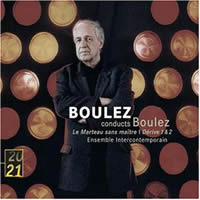Boulez: A Master Speaks Anew
|
Dan Albertson [September 2005.]
Pierre BOULEZ: Le marteau sans maître (1953-55); Dérive 1 (1984); Dérive 2 (1988/2002). Hilary Summers (mezzo-soprano); members of Ensemble InterContemporain, Pierre Boulez (cond.). Deutsche Grammophon 00289 477 5327. There may be no post-World War II work for voice and instrumentalists more famous than Pierre Boulez’s 1950s song cycle Le marteau sans maître. The music’s striking mix of alto voice (here a mezzo-soprano), alto flute, guitar, viola, vibraphone, xylorimba and percussion, deft interweaving of instrumental and vocal passages and the simultaneous, seamless unfolding of three separate cycles-within-a-cycle — to name but a few of its qualities — set it apart. It is also a work disdained by the less adventurous for its supposed rigor and inflexibility. The music operates for many listeners as a line of demarcation, no doubt. Time has withered its novel effects, but the content remains as strong today as at its inception, 50 years ago. This recording is the first on a disc to be easily available stateside. Albeit more confined and moderate in approach — in other words, “safe” — it compares favorably with three LPs in my collection. Technically, the performance seems note-perfect and the music remains thrilling; however, the verve of earlier recordings has been replaced with a sense of familiarity. Summers and a sextet of EIC’s finest musicians perform almost mechanically, perhaps because they didn’t need to learn any new techniques. For earlier performers, this was difficult sailing. Today the music’s challenges are commonplace, its direction clearly defined from the outset. Le marteau sans maître is not at all an open-form work, and yet earlier musicians brought more creativity to these same firmly fixed notes. I’m not complaining, exactly — quibbling, rather. Precision is never to be discounted. Dérive 1 and 2 are vastly different creations. Dérive 1, marked Très lent, immuable, a mere six minutes long, features a stately prologue and epilogue, and an explosive middle replete with undulations from the six instrumentalists involved: flute, clarinet, violin, cello, piano and vibraphone. The music has been subtly revised since it was last recorded on Erato, but the overall experience is unchanged, and the charming Paul Sacher motif (the notes E-flat, A, C, B, E, D) remains its principal joy. Dérive 1 is a pristine, undervalued jewel, easy to overlook. By contrast, Dérive 2 (a first recording), marked Très rapide, is nearly 25 minutes in length. The work is scored for English horn, clarinet, bassoon, French horn, violin, viola, cello, harp, piano, vibraphone and marimba. The drive of the earlier work’s middle section has been transformed into a nigh-raucous moto perpetuo, like nothing else in Boulez’s catalogue. As always, the composer amazes with his control of timbre and the range of variation his limited instrumentation achieves. The sublime interplay amongst ever-shifting factions of the ensemble identifies Boulez’s continually refreshing craft, as compelling today as ever. It should come as no surprise that the musicians of EIC play with an enthusiasm second to none. Even in the somewhat mechanical Marteau, these virtuosi are never less than convincing.
[More Dan Albertson]
[More
Boulez]
[Previous Article:
Kipple 3.]
[Next Article:
Storage Stories]
|
